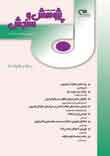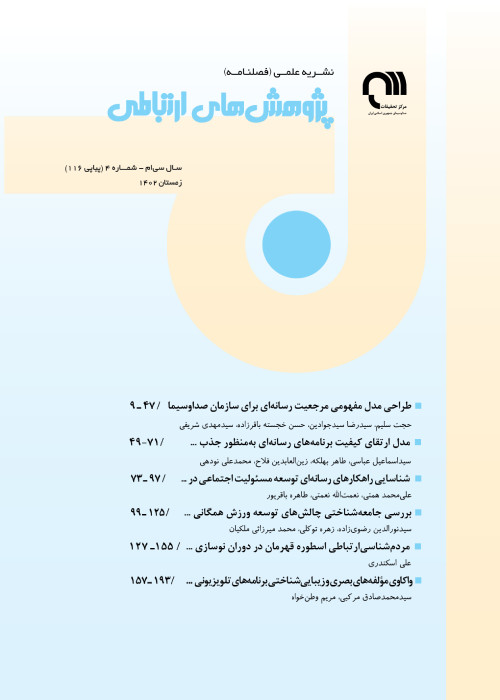فهرست مطالب

فصلنامه پژوهش های ارتباطی
پیاپی 52 (زمستان 1386)
- تاریخ انتشار: 1386/10/11
- تعداد عناوین: 9
-
صفحه 5
-
صفحه 7تغییرات خانواده در طول زمان و چگونگی نمایش آن در تلویزیون موضوع مورد بحث این مقاله است. مقاله حاضر با نگاهی به پژوهش های صورت گرفته در طول سال های 1370 تا 1383 در این زمینه، سعی در مشخص کردن تغییرات خانواده در نمایش های تلویزیونی دارد.
یافته های تحقیق برخی تغییرات را در نمایش خانواده در تلویزیون نشان می دهد مانند: افزایش سطح تحصیلات و نوع شغل، توجه بیشتر به آسیب های اجتماعی از جانب خانواده ها و نزدیک شدن برخی از کلیشه های مردانه و زنانه به یکدیگر. مردان بیشتر از سابق ویژگی همدلی و همدردی با دیگران را نشان می دهند اما زنان در اغلب موارد به صورت افرادی پرخاشگر به نمایش درآمده اند. در مورد تقسیم نقش در خانواده نیز هر چند برخی تغییرات ظاهری به چشم می خورد، هنوز روابط سنتی در خانواده پا بر جا است.
-
صفحه 35مقاله حاضر، مطالعه بنیادی عناصر شکل گیری هویت زنان در جوامع مختلف است که رسانه را از جمله ابزارهای انتقال یا تشدید نگرش های حاکم بر جامعه درباره زنان معرفی می کند.
نویسنده در این مقاله، ابتدا به تعریف هویت و رابطه آن با جنسیت می پردازد و سپس، نحوه شکل گیری هویت زنانه در جوامع مختلف و عناصر اساسی این هویت را برمی شمرد.
-
صفحه 83این مقاله بر گرفته از پژوهشی است که در مرکز تحقیقات صدا وسیما به منظور بررسی میزان و نحوه پرداختن به سبک زندگی (طبقات مرفه، متوسط و پایین)جامعه در سریال های خانوادگی پربیننده شش ماهه دوم سال 1385 انجام شده است.
مهم ترین یافته های این پژوهش حاکی از آن است که مجموعه های تلویزیونی خانوادگی پر بیننده به طور کلی مسایل، مظاهر و سبک زندگی طبقات مرفه را بیش از طبقات متوسط وپایین انعکاس داده اند.
-
صفحه 115بازنمایی زنان در آگهی های بازرگانی و جایگاه جنسیت در تبلیغات بخشی از مهم ترین و شاید جذاب ترین مطالعات ارتباطی است که اغلب زیرمجموعه مباحث جامعه شناسی تبلیغات قرار می گیرد. مطالعات داخلی و خارجی متعددی که در این زمینه انجام شده، ابعاد متنوعی از چگونگی بازنمایی جنسیت در آگهی ها را مورد توجه قرار داده است اما در این میان (و به طور خاص در ارتباط با زنان) دو موضوع «استفاده ابزاری از زنان در صور غیر اخلاقی» و «بازنمایی زنان در نقش های سنتی و تکرار کلیشه های جنسیتی با تاکید بر تفاوت های زن و مرد» بیش از سایر موضوع ها، مورد توجه محققان علوم ارتباطات و نیز جامعه شناسان قرار گرفته است. این مقاله، موضوع دوم یعنی چگونگی بازنمایی زنان در قالب نقش های سنتی و بازتولید کلیشه های جنسیتی در تبلیغات را مورد توجه قرار داده است.
-
صفحه 137این پژوهش در پی بررسی این موضوع است که آیا بین تلویزیون و نهاد خانواده و مدرسه در انتقال ارزش ها و هنجارهای اجتماعی به دانش آموزان مقطع دبیرستان شهر تهران هماهنگی وجود دارد یا خیر و در صورت وجود این هماهنگی، میزان آن چقدر است. برای رسیدن به این هدف، سریال نرگس به عنوان نمونه ای از برنامه های تلویزیون، پدر و مادر به عنوان نماینده خانواده و آموزگاران به عنوان نماینده مدرسه انتخاب شدند.
از مهم ترین نتایج این پژوهش می توان به این مورد اشاره کرد که تلویزیون (سریال نرگس) ونهاد خانواده تنها در زمینه هنجار وفاداری به همسر با یکدیگر هماهنگ هستند و در ارزش هایی چون علم، ثروت، تقوا، محبت و احترام و همچنین هنجارهایی مثل صداقت، وفاداری به کشور، وفاداری به عهد و پیمان و قانون گرایی بین آنها هماهنگی وجود ندارد.
-
صفحه 163مقاله پیش رو تلاشی برای نشان دادن اثرات مختلف تلویزیون بر کودکان است.برای این منظور ابتدا، به اثرات مثبت آن از جمله: رشد فکری و هوش بهر (I.Q) کودکان پرداخته شده ودر ادامه، اثرات منفی این رسانه که بروز بیماری، خشونت، ضعف بینایی و کاهش خلاقیت در کودکان را شامل می شود، مشخص شده است. در خاتمه نیز راهکارهایی برای بالا بردن رشد فکری کودکان ارائه شده است.
-
صفحه 181مقاله حاضر مروری دارد بر روند افزایش جمعیت در ایران، سپس سیاست های کنترل جمعیت را که توسط دستگاه های امنیتی دولت امریکا طراحی شده و در سراسر جهان از طریق دستگاه های دولتی و غیر دولتی پیاده می شود، تشریح می کند و به نقش رسانه ها در ترویج و بومی نمایی این سیاست ها اشاره می کند.
-
Page 7This article discusses the changes a family undergoes in a TV series as well as the way these changes are presented in the series. It also uses the studies carried out between 1990 and 2002 on this field to clarify these changes.The research findings determine some of these changes in presenting family in TV series. For example; raising the level of education, type of job, more attention to social problems on part of families, more similarities in men and women stereotypes. Men show more sympathy to others than before. However, Women are often presented as aggressive. Regarding the division of family roles, Some changes are observable but still traditional relationship rule over family and even there are some traditional conceptions which are ruled out in the present society.
-
Page 35The present article is based on a study which deals with elements constructing the identity of women in different society. It looks at media as a means for conveying or underlying the views common in the society on women. The author, first, defines "identity" an its relation with gender, then he discusses the process in which female identity is constructed in different societies and he, finally, mentions the basic element forming the identity of women.
-
Page 57The present article is based on a study which examines the way marriage and divorce are presented in the Iraninan TV series. In This research some cases from among the series showed from channel 1, 2, 3, and 5 in the first 9 months of the Iranian year 1384 were selected. The samples contained at least one of the two phenomena, either marriage or divorce. The series selected are as follows: "The Assignment of Love" and "The Small Farm" from channel one; "He Was an Angel", "Cocoon of Flight", and "Until the Sunset" from channel two; "The Accused Fled", "One Night … "', and "Reihaneh" from channel 3; "For the Last Time" and "Heart" from channel 5.The series were studied by the method of Content Analysis. Of the interesting results of the research is the fact that about half of the marriages in these cases were only to make the series appealing for the audience.
-
Page 83The present article, based on a research carried out in IRIB Research Center, aims to investigate how and to what extent the most watched Iranian TV series in the second half of the year 2006 address life styles in society.The research finding show that the most watched TV Series have reflected the life style of the affluent class of the society more than that of the middle or low classes.
-
Page 115Representation of women in commercials and the role of gender in advertisements are perhaps two of the most important and interesting subjects of communications studies which are often a sub-category of sociology of advertisement. The bulk of foreign and domestic studies conducted in this regard address different approaches to representation of gender in advertisements. However, there are only two subjects (particularly regarding women) in these studies that researchers in sociology and communications sciences have focused on:"Treating women as tools in form of immoral images" and "representation of women in traditional roles and repeating gender clichés with a special focus on men and women's differences. "The present article deals with the latter, i.e., representing women in advertisements while adopting traditional roles and gender clichés.
-
Page 137This article is based on the author's MA. thesis which was carried out in 2007 under the supervision of Dr. Hormozizadeh in IRIB College.The article raises the question whether there is a harmony between TV, family and school in conveying social values and norms to Tehran's high school students, and, if any, to what extent this goal is achieved. To this aim, the TV series Nargas as a sample of TV programs, father and mother as the family representatives and teachers as the school representatives were selected.
-
Page 163The present article is an attempt to show the different impacts of TV on children. The article, first, addresses the positive effects of TV on children, including: Children's mental growth and their IQ. Then, it studies the negative effects of it, including: Illness, violence, eyesight weakness, and decreasing children's creativity. The article, finally, suggests some approaches for raising children's mental growth.
-
Page 181The present article first reviews the trend of population growth in Iran then explains the population control policies designed by the United State's security apparatus and implemented by the country's governmental and non-governmental organizations throughout the world. Finally, it addresses the role of media in spreading and localizing these policies.


